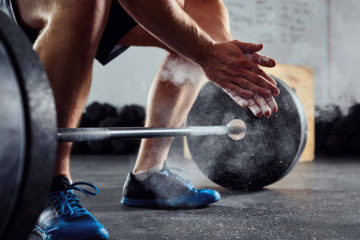The Mountain Climber - Reach your peak with this workout

Mountain climbers: targeted muscles
- Abs
- Back extensor
- Triceps
- Hamstrings
- Glutes
- Chest
- Hip flexors
Mountain Climbers are a great addition to any full-body workout, as they stimulate the stabilization of the body. They are particularly good for your core. So integrate them skillfully into your workout plan. If you want to learn more about this topic, take a look at our page on the topic of ab training.
The correct form for mountain climbers
Start in the push-up position. Put your arms shoulder-width apart and your feet about hip-width. Your shoulders should be directly above your hands and should remain in this position throughout the exercise. Keep your back straight, avoid hunching or sagging your back. Now pull your knees in a leaping motion alternately in the direction of your chest. The other leg is stretched back, as in the normal push-up position, a kind of running on the spot in the push-up position. Continuous tension in your entire body is the essential for this exercise. As you take each step, make sure that you keep your bottom in line with your shoulder and back leg.
Weight recommendation for mountain climbers

You don’t need any extra weights for the basic execution of mountain climbers. If you want to add variation, you can increase the difficulty by adding weights (e.g. on your feet).
Equipment for mountain climbers
No equipment or extra weight is required. You only work with your body weight. Equipment can be used for different variations of the mountain climber. More on this under “Variations”.
Variations of mountain climbers

The mountain climber is a very versatile exercise. One variation is to turn your hips during the movement. Pull your knee under your chest diagonally in the direction of your opposite elbow. By turning it slightly, the focus is more on the oblique muscles.
Another variation is to change up the speed. You can increase the pace slowly within the exercise or stick to your chosen pace. Changing the intensity is a third option. If the normal mountain climber is too difficult for you, put your hands on a raised area.
If you want to increase the level of difficulty, put your feet up higher. In addition, mountain climbers do not always have to be executed at maximal speed. You can just as easily do them “walking”. Here you don’t pull your knee forward explosively and keep your foot in the air, but instead move your feet forward to your chest and back into the push-up posititon.
The last variation is the side mountain climber. To do this, bring your knees to the right or left of your upper body in the direction of your elbow. This variation works your lat muscles.
Common mountain climber mistakes

- Too much upper body movement: The movement should come from your hips and legs. Try to keep your shoulders above your hands so that your upper body isn’t tempted to move.
- Tilted back: Make sure that your back stays straight and doesn’t hunch. Keeping your core tensed will help with this.
- Incorrect leg / shoulder position: Your shoulders and legs should not be positioned too closely. Ideally, they should be hip-width apart. This stabilizes your body and the exercise will become a lot easier for you.
- Bottom too high: it is often the case that the feet get closer and closer to the hands during the exercise. Eventually you end up in more of a downward dog position than a push-up position. In this case, choose an elevated position for your hands to make the exercise easier.
- Incorrect leg movement: Many people tend to pull their heel to their bottom rather than the knee forwards. As you move, imagine you want to pull your knee up to your chin to get the correct movement.
Which workout plans contain the mountain climber?
Let mountain climbers enhance your ab workout and boost the stabilisation of your body.
Frequently asked questions and answers
With mountain climbers you work your whole body. The following muscle groups are involved in the exercise: abs, back extensors, triceps, hamstrings, glutes, chest and your hip flexors. Basically a full body workout with just one exercise.
- Turn your hips during the movement. Pull your knee under your chest diagonally in the direction of your opposite elbow. By turning it slightly, the focus is more on the oblique muscles.
- Changing the speed. You can increase the pace slowly during the exercise or keep to your chosen pace.
- Changing the intensity. If the normal mountain climber is too difficult for you, put your hands on a raised area. If you want to increase the level of difficulty, put your feet up higher.
- Mountain climbers do not have to be executed at maximal speed only. You can just as easily do them “walking”. Here you don’t pull your knee forward explosively and keep your foot in the air, but instead move your feet forward to your chest and back in push-up posititon.
Start in the push-up position. Put your arms shoulder-width apart and your feet about hip-width. Your shoulders should be directly above your hands and should remain in this position throughout the exercise. Keep your back straight, avoid hunching or sagging your back. Now pull your knees in a leaping motion alternately in the direction of your chest. The other leg is stretched back, as in the normal push-up position, a kind of running on the spot in the push-up position. Continuous tension in your entire body is essential for this exercise. As you take each step, make sure that you keep your bottom in line with your shoulder and back leg.



